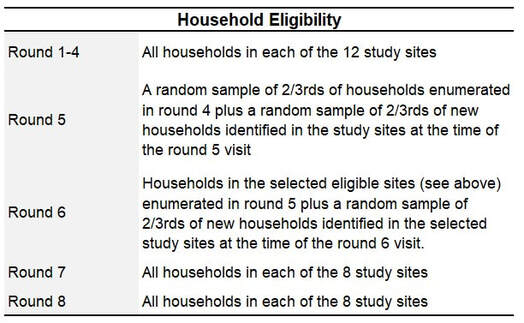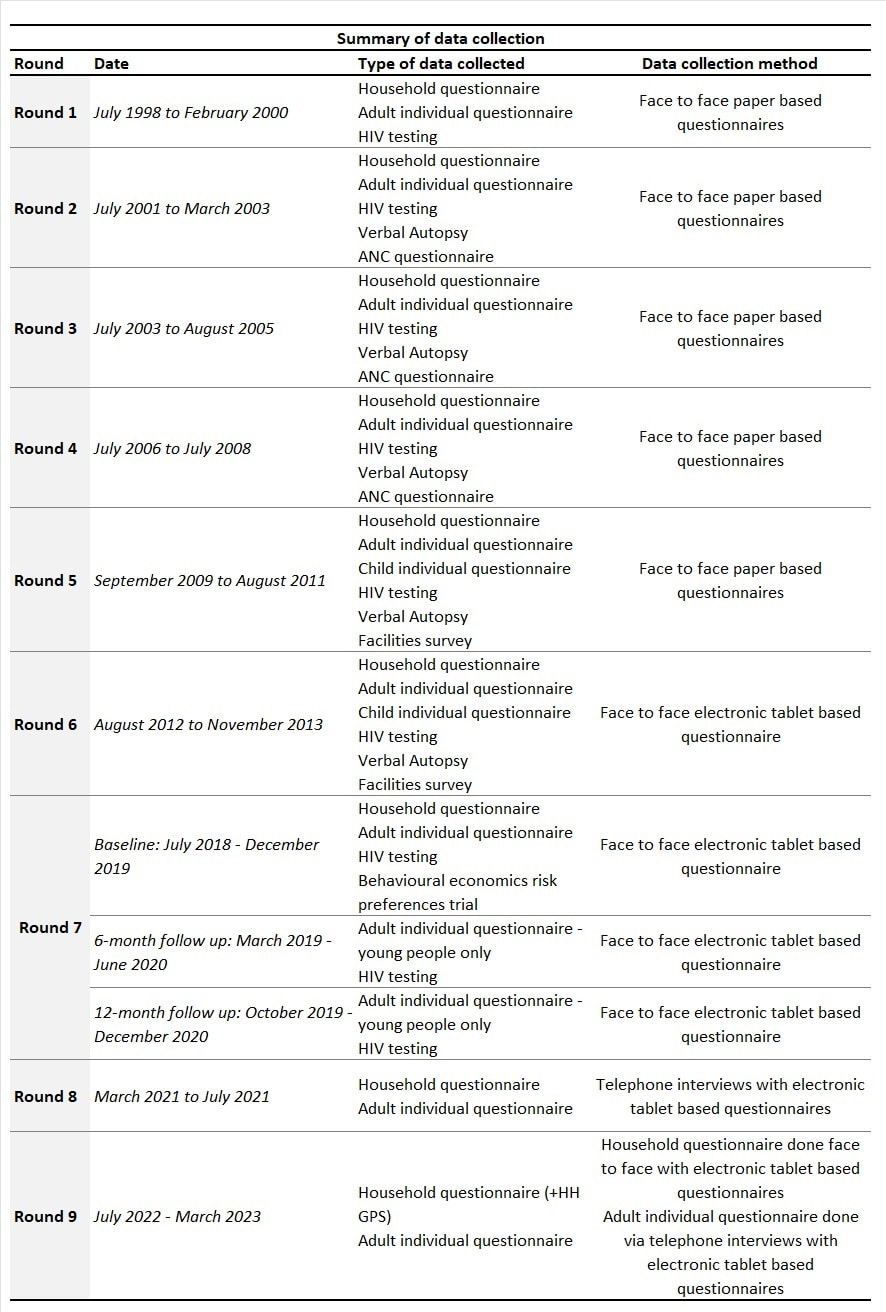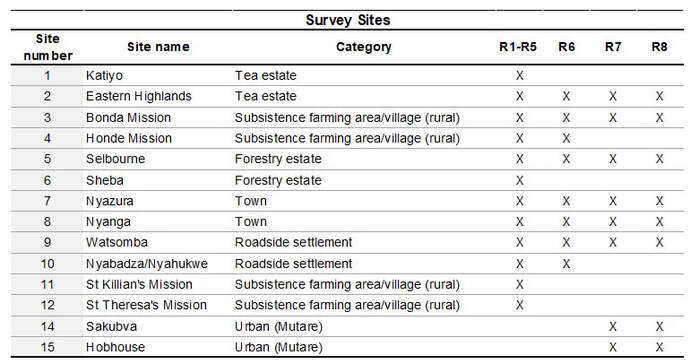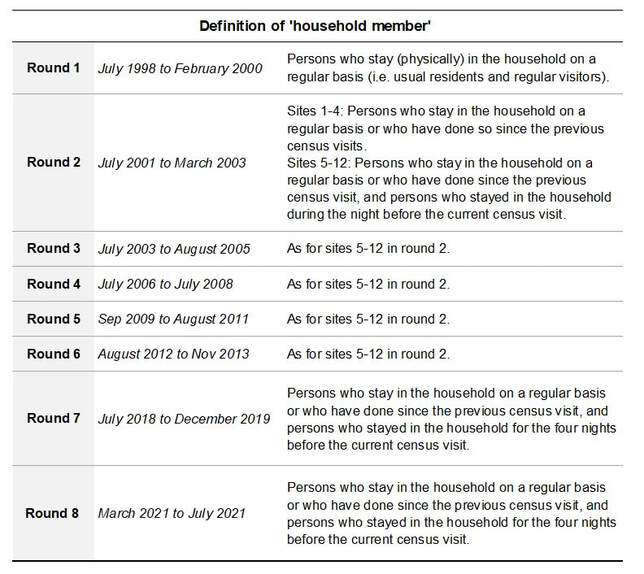Survey round information
|
8 rounds of the cohort survey, consisting of household and individual questionnaires as well as HIV testing, have been completed from 1998 to 2021. Data collection dates and key information details are summarised in this table. Due to COVID-19 interruptions, some data have been collected via telephone survey. In the round 7 12-month follow up survey, 4 out of 8 sites of individual questionnaires had to be completed via telephone survey with appointments then being made to carry out HIV testing. In round 8, household and individual questionnaires were carried out via telephone. |
Survey eligibility criteria
Over time, changes have been made to the eligibility criteria of the survey; both in the household census and the general population cohort.
Survey data are typically gathered from the study sites listed in the table below.
Survey data are typically gathered from the study sites listed in the table below.
|
Sites 1, 5, 11 and 12 dropped from the survey after round 5. Round 6 of the survey therefore consisted of only 8 sites. In round 7, 2 further sites were dropped and 2 urban sites were added. Round 8 consisted of the same sites as in round 7. What follows is a more detailed account of eligibility criteria for both household and individual surveys.
|
Household Census
A ‘household’ in this instance is defined as people who share/eat from the same cooking pot. However, the definition of a household member changed between round 1 and 2 of the survey, as detailed in the table below.
A ‘household’ in this instance is defined as people who share/eat from the same cooking pot. However, the definition of a household member changed between round 1 and 2 of the survey, as detailed in the table below.

In round 1 of the survey , household listings provided by the Zimbabwe Central Statistics Office were used. In subsequent rounds, these listings were updated based on information provided by village guides. In most cases, the guides were village community health workers. As stated above, 4 of the 12 sites that participated in the study were excluded from the study. Further to this, restrictions were also placed on household eligibility with round 5 and 6. In rounds 7 and 8, all households within the study sites were eligible for participation in the household questionnaire.
General Population Cohort
Round 1
Men aged 17-54 years and women aged 15-44 years who had slept in an enumerated household in a study site for at least 4 nights in the last month and who had also been staying in the same area at the same time one year prior to the interview date. Within any given marital grouping (i.e. a husband and one or more wives), one member of the grouping was selected at random (without replacement) as eligible for interview in the general population cohort.
Round 2
All men and women enumerated in a household in a study site and interviewed as a participant in the general population cohort in round 1 (regardless of whether their ages now exceeded the initial age-limit) and still resident in the same study site. Also, all men and women who were below the relevant age-limit (i.e. 17 and 15, respectively) at round 1 but who were aged above this age-limit (‘previously under-age’) and met the residence criteria at the time of the round 2 census were treated as eligible. In sites 1-4, new in-migrants and visitors were treated as ineligible for the study. In sites 5-12, new in-were treated as eligible and the residence criteria were dropped. Round 1 participants reported to have out-migrated to neighbouring areas or to the cities of Harare or Mutare were also treated as eligible and followed-up; these individuals were treated as living in ‘site 13’ in round 2.
Round 3
The eligible age-ranges for both men and women were each extended to ages 15-54 years; except for previous cohort participants who continued to be eligible if they now exceeded the upper age-limits. All previously under-age household members and new in-migrants and visitors (in all sites) were considered eligible and the restriction to one interview per marital grouping (applied in rounds 1 and 2) was dropped. All out-migrants were excluded from eligibility for interview.
Rounds 4 and 5
Individual eligibility criteria as in round 3 (but restricted to 2/3rds of households).
Round 6
Individual eligibility criteria as in round 3 (but restricted to 2/3rds of households in 8/12 study sites).
Round 7
The minimum eligible age for both men and women remained at 15 years and there was no upper age limit. All previously under-age household members and new in-migrants and visitors staying for at least the previous 4 nights (in all sites) were considered eligible. All out-migrants were excluded from eligibility for interview. All females aged 15-24 years and males aged 15-29 years meeting the other eligibility criteria were eligible. A random 2/3 sample of females aged 25+ years and males aged 30+ years meeting the other eligibility criteria were eligible.
Round 8
Individual eligibility criteria as in round 7 (but restricted to 2/3 of households in all study sites)
Round 1
Men aged 17-54 years and women aged 15-44 years who had slept in an enumerated household in a study site for at least 4 nights in the last month and who had also been staying in the same area at the same time one year prior to the interview date. Within any given marital grouping (i.e. a husband and one or more wives), one member of the grouping was selected at random (without replacement) as eligible for interview in the general population cohort.
Round 2
All men and women enumerated in a household in a study site and interviewed as a participant in the general population cohort in round 1 (regardless of whether their ages now exceeded the initial age-limit) and still resident in the same study site. Also, all men and women who were below the relevant age-limit (i.e. 17 and 15, respectively) at round 1 but who were aged above this age-limit (‘previously under-age’) and met the residence criteria at the time of the round 2 census were treated as eligible. In sites 1-4, new in-migrants and visitors were treated as ineligible for the study. In sites 5-12, new in-were treated as eligible and the residence criteria were dropped. Round 1 participants reported to have out-migrated to neighbouring areas or to the cities of Harare or Mutare were also treated as eligible and followed-up; these individuals were treated as living in ‘site 13’ in round 2.
Round 3
The eligible age-ranges for both men and women were each extended to ages 15-54 years; except for previous cohort participants who continued to be eligible if they now exceeded the upper age-limits. All previously under-age household members and new in-migrants and visitors (in all sites) were considered eligible and the restriction to one interview per marital grouping (applied in rounds 1 and 2) was dropped. All out-migrants were excluded from eligibility for interview.
Rounds 4 and 5
Individual eligibility criteria as in round 3 (but restricted to 2/3rds of households).
Round 6
Individual eligibility criteria as in round 3 (but restricted to 2/3rds of households in 8/12 study sites).
Round 7
The minimum eligible age for both men and women remained at 15 years and there was no upper age limit. All previously under-age household members and new in-migrants and visitors staying for at least the previous 4 nights (in all sites) were considered eligible. All out-migrants were excluded from eligibility for interview. All females aged 15-24 years and males aged 15-29 years meeting the other eligibility criteria were eligible. A random 2/3 sample of females aged 25+ years and males aged 30+ years meeting the other eligibility criteria were eligible.
Round 8
Individual eligibility criteria as in round 7 (but restricted to 2/3 of households in all study sites)
Child Survey
A child survey was also conducted for which the eligible age-range was 2-17 years. A random sample of 1/6th of the children in this age-range listed in the household census was selected for interview in the child survey. Children aged 15-17 years selected for the child survey remained eligible for the general population cohort interview but overlapping sections were skipped. Two rounds of the child survey have now been completed; data for these alongside rounds 5 and 6 of the adult survey.
A child survey was also conducted for which the eligible age-range was 2-17 years. A random sample of 1/6th of the children in this age-range listed in the household census was selected for interview in the child survey. Children aged 15-17 years selected for the child survey remained eligible for the general population cohort interview but overlapping sections were skipped. Two rounds of the child survey have now been completed; data for these alongside rounds 5 and 6 of the adult survey.


